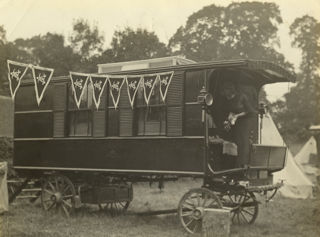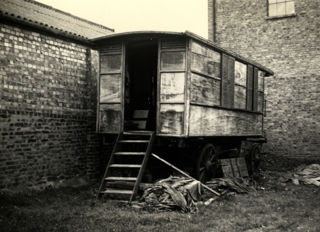
The Wanderer’s Journey
12 July 2022
The world’s first caravan which was purpose built for holidays, The Wanderer, is the crown in the Caravan and Motorhome Club’s historic holdings. A collection of letters and photographs shows how it is only by chance that this unique Victorian caravan still survives. Explore The Wanderer’s journey through the 20th century.
In 1885 an incredible novelty took to the road, a fantastic horse-drawn coach-built caravan in gleaming mahogany, the first to be designed especially for leisure travel. The Wanderer’s two tonnes (2,000 kg) in weight were pulled by two horses imaginatively named Captain Cornflower and Polly Peablossom. They were preceded on the road by a valet riding a Ranalegh tricycle to check and clear the route ahead. The caravan’s owner, Dr William Gordon Stables, was a retired Royal Naval Surgeon who had gained some celebrity as an author of adventure stories for boys, which drew on his own experiences at sea. The first journey taken by Dr Gordon Stables in his ‘Land Yacht’ was 1300 miles from his home in Twyford, Berkshire to Inverness in Scotland. The Doctor saw many parallels between a caravan and a boat, which is why The Wanderer is always fondly referred to as ‘she’ in the same way that a sea vessel would be. At her destination, the caravan was loaded onto a train where she returned to London by rail before the journey continued by road along the south coast as far as Lymington in Hampshire. Every summer that went after, the Doctor took to the road, clad in his striking Highland dress with a variety of pets and sometimes one of his children in tow. He often penned his latest novel or an article on the journey.

On the formation of The Caravan Club in 1907 (today known as the Caravan and Motorhome Club), amidst the growing popularity of a pursuit that Dr William Gordon Stables had done much to pioneer and promote, he was made its first Vice-President. Yet his ill health prevented him from taking any active role, and in 1910 he passed away after a long illness, with The Wanderer’s future immediately plunged into uncertainty. The caravan was put up for auction as part of his estate, and was immediately bought back by his wife and one of his daughters Ottoline. This purchase at first seems sentimental, but the family did not intend on keeping the caravan for long. When The Wanderer became the star attraction in 1911 at the then Caravan Club’s Meet at Coulsdon, held in celebration of the Coronation of King George V, she featured a ‘For Sale’ sign which was reported in various press. But a sale was not to be and she remained in the safe keeping of the Gordon-Stables family. Several years later in 1914 she remained unsold, with The Caravan Club’s founder J Harris Stone unsuccessfully calling on the South Kensington authorities to place the caravan in the Victoria and Albert Museum.
For the rest of the decade nothing is known of The Wanderer and there is no evidence of her having been used for touring, the caravan would now have been seen as particularly cumbersome in comparison to its more lightweight successors. Miss Ottoline Gordon-Stables was busy building a reputation as a ‘Famous London Skin and Complexion Specialist’, by following her father’s interest in health to grow her own business. Her company ‘Luckstone and Ottolene Toilet Preparations’, offered a variety of products including face cream, hand lotions and nail polish, which were stocked and demonstrated in department stores across the UK from around 1912, and later expanding to the United States.

On the outbreak of the First World War in 1914, caravan holidays were paused for the duration of the conflict as all energy turned to the war effort. The horses required to tow holiday caravans were requisitioned by the government, and as a result many Club members followed by voluntarily offering their caravans for use on the front line as mobile first aid units and command centres. The Wanderer remained at home, being one of the many reasons why she has survived to this day when so many holiday caravans from the pre-First World War era were destroyed.
By 1924 The Wanderer had entered storage at Cobtree Manor in Maidstone, Kent, and there is no evidence that she was used to take a holiday after this time. By now, the horse-drawn caravan was now a novelty of the past and had made way for a new generation of modern, lightweight trailer caravans towed by the increasingly popular motor car. Now a successful businesswoman, Miss Ottoline Gordon-Stables spent her time between Britain and the United States. In 1936, she published a popular handbook on beauty, and in the same year The Wanderer moved to the storage company S.P. Sanders Ltd. in Maidstone where it was to spend many years to come.

By the early 1950s, unused and in storage for decades, The Wanderer had fallen into disrepair. For Miss Ottoline Gordon-Stables, the caravan that she had first planned to sell over 40 years earlier was becoming too costly to store. A renewed quest to find a permanent home for The Wanderer befitting of its history began, so that she might be restored and preserved for the future. The caravan was first offered to The Science Museum, who declined, before Miss Gordon-Stables turned her attention to the United States where it was unsuccessfully offered to the Trailer Coach Manufacturers Association, The Henry Ford Museum and a number of private buyers. In 1957, it was offered to the then Caravan Club on the occasion of its 50th anniversary. Yet despite Miss Gordon-Stables being a Vice-President of the organisation, the cost of restoration was considered too high and the offer was declined. By 1960 all avenues to find a new home for The Wanderer had been exhausted. In disrepair, rapidly deteriorating and with mounting storage costs Miss Gordon-Stables made the sad instruction for the caravan to be destroyed.
But as we know, incredibly the caravan survives to this day, so perhaps the storage company where The Wanderer had been kept for twenty-five years never had the heart to see the instruction through, or perhaps they simply had not got around to it. The following year in 1961, the Club received news following the death of Miss Gordon-Stables that she had bequeathed the caravan to them. Yet the rumour of its destruction quickly circulated, which was immediately investigated by a member of Club staff who was surprised to find The Wanderer intact, but in severe disrepair, in the yard of the storage company Sanders in Maidstone. In May 1961 the caravan dealership Maidstone Caravan Company removed her from storage before she travelled to Staffordshire for a full restoration with a company called Fleetwood Brothers, fulfilling Miss Gordon-Stables dearest wish.
The Wanderer was fully restored and ready to be seen by the public once more by 1964. It had been over 50 years since the caravan had last attended a Club event, and she was as much an attraction to members at the Club’s National at Burghley Park as she had been at Coulsdon in 1911. The same year a long-term home was found for her at the then Bristol Industrial Museum, in the city where she was originally built, where she stayed until the Museum closed in 2006. She only took to the road on her own wheels once more in 1982 when she travelled from Bristol to the Royal Windsor Horse Show in commemoration of the Club’s 75th anniversary, stopping en-route at Twyford in Berkshire where she had begun so many adventures with Dr William Gordon Stables nearly a century earlier.
The Wanderer caravan is currently housed at the Broadway Caravan and Motorhome Club Site.

Subscribe for updates
Get our latest news and events straight to your inbox.

